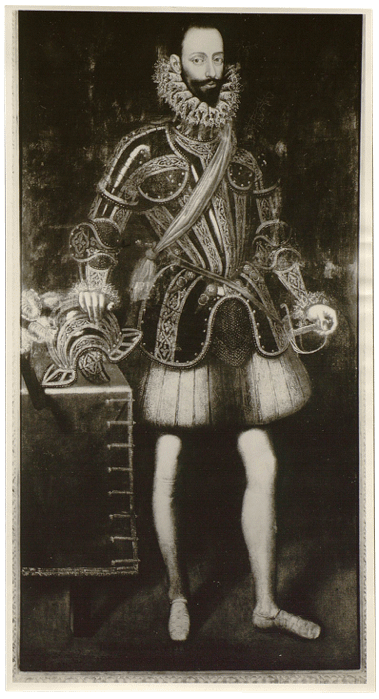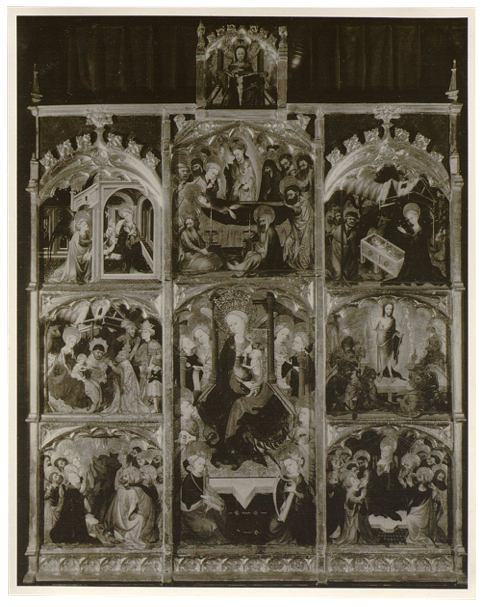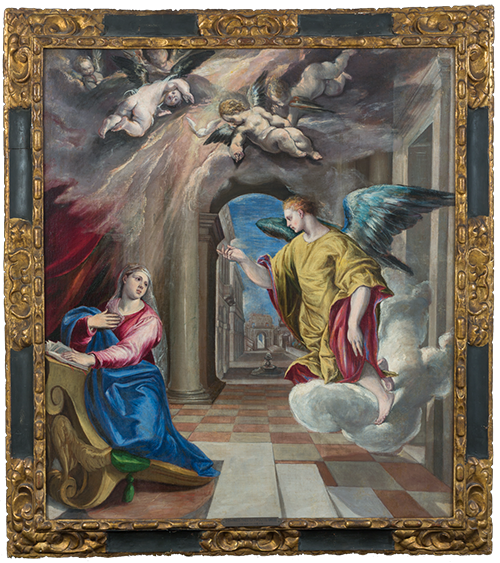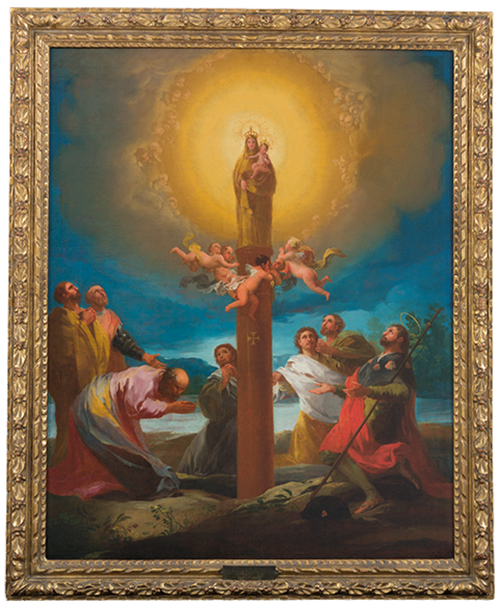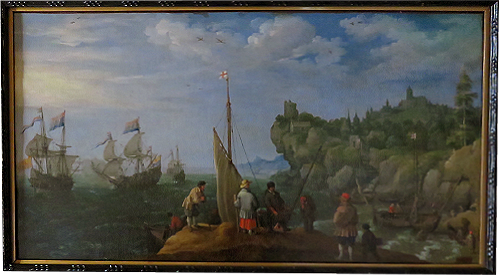Notheworthy works
Juan Pantoja de la Cruz (1553-1608)
Portrait of Gregório Taumaturgo de Castelo-Branco, third Count of Vila Nova de Portimão
c. 1600
Oil on canvas
193 × 97 cm (frame)
MR0133
Juan Pantoja de la Cruz (1553–1608) was a Spanish Renaissance painter with a Mannerist aesthetic. A pupil of Alonso Sánchez Coello, he specialised in court portraits and was named court painter under Philip II of Spain and official court portraitist during the reign of Philip III. The portrait of Gregório de Castelo-Branco is a prime example of Pantoja de la Cruz’s work.
It is a portrait in a conventional format where the subject poses standing up, looking straight at the viewer in front of a neutral, dark background. For symbolic reasons, his right hand is resting on a helmet, while his left hand is holding the hilt of the sword he is carrying in his belt. The artist’s mastery comes through in the painstaking depiction of the details in the subject’s clothing.
This painting is part of a pair, alongside the portrait of Magdalena de Vilhena e Lencastre, the count’s niece, which also belongs to the collection.
Gonçal Peris i Sarrià (documentat entre 1380-1451)
Altarpiece of Our Lady of the Milk
Early fifteenth century
Egg tempera on wood
212 × 178 cm
MR0246
This is Gothic altarpiece dedicated to Our Lady of the Milk by Gonçal Peris i Sarrià. The Virgin is represented on the lower middle panel sitting on a throne, surrounded by angels and breastfeeding the infant Jesus. Each of the side panels depicts episodes from the life of Mary and from Jesus’s childhood. On the right, from top to bottom, are the Nativity, the Resurrection and the Pentecost. On the left, from top to bottom, are the Annunciation, the Epiphany and the Ascension. On the upper part of the middle third of the altarpiece is the Dormition, and on top of that, the Trinity.
Gonçal Peris i Sarrià, who came from a family of painters, is one of the most prominent Valencian painters from the first half of the fifteenth century. He was trained in Pere Nicolau’s workshop and went on to set up his own, which became renowned.
Doménikos Theotokópoulos (el Greco) (1541-1614)
The Annunciation
1577-1580
Oil on canvas
109 × 98 cm
MR0136
The Annunciation is a painting by the famous painter from Crete and one of the most noteworthy late Renaissance artists, El Greco.
The Annunciation is a recurring theme in El Greco’s work. Here, the Archangel Gabriel, floating on a cloud on the right-hand side, makes an announcement to the Virgin, who is kneeling on a prie-dieu on the left. The scene is surmounted by a group of angels. The architectural backdrop consists of a floor, clearly painted in perspective, and a door between columns, through which an urban exterior can be seen. Light and colour dominate the entire piece.
Two similar versions of this work are kept in the Museo Nacional del Prado and the Museo Nacional Thyssen-Bornemisza.
Francisco de Goya y Lucientes (1746-1828)
The Apparition of Our Lady of the Pillar
Second half of the eighteenth century
Oil on canvas
105 × 84 cm
MR0084
The Apparition of Our Lady of the Pillar, by the Aragonese painter Francisco de Goya, is one of many depictions of this scene that the artist made, and it may have been a commission for an individual for devotion purposes. Here, the Virgin appears on the column with the infant Jesus in her arms, occupying the central axis of the composition. Meanwhile, the disciple James, carrying a crosier on the right, is represented kneeling at the foot of the column, praying next to his followers on the banks of a river (possibly the Ebro). A group of angels surround the column at the feet of the Virgin, who is surrounded by a halo with angels’ heads at its edges.
Adam Willaerts (1577-1664)
Seascape with Dutch Scenery
1622
Oil on canvas
36 × 66 cm
JMR0241
This is a meticulous, lively, colourful, Flemish-inspired painting by Adam Willaerts. This Dutch Baroque artist, who founded the Utrecht Guild of Saint Luke, was clearly influenced by the paintings of Hendrik Cornelisz Vroom and Pieter Bruegel the Elder. Willaerts is known for his paintings of seascapes and coastal landscapes, in which he combines the seascape painting tradition with depictions of everyday life. Beach and port scenes with fishermen and other figures in the foreground and rocky landscapes sharing the backdrop with boats in the sea are the hallmarks of this artist.
The piece held by the Foundation is a typical Willaerts composition: a partial view of a coastal town, presumably a Dutch port, with figures on a promontory in the foreground, and fishermen unloading the day’s catch on the beach. The small human figures add a sense of action and movement to the painting. The background composition consists of the sea with sailboats and a cliff on the right-hand side with steps and the city’s buildings.
